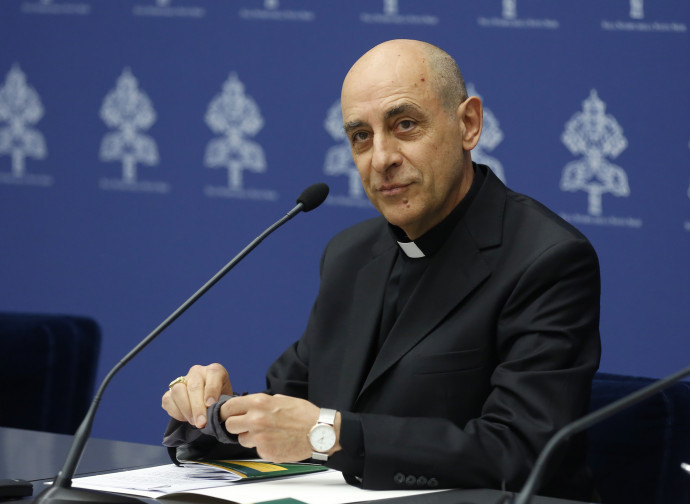The Vatican confuses the issue by rejecting Mary Coredemptrix
The Dicastery for the Doctrine of the Faith judges it inappropriate to speak of Coredemptrix. This title, which was used several times by Saint John Paul II for Fernández, risks 'obscuring the unique salvific mediation of Christ'. However, Mater Populi Fidelis is just another confusing document, starting with an inaccurate reconstruction that downplays the contributions of saints and theologians.

On Tuesday, 4 November, the Dicastery for the Doctrine of the Faith published an 80-paragraph doctrinal note titled Mater Populi Fidelis, approved by Pope Leo XIV. In it, we are told that, 'Given the need to explain Mary's subordinate role to Christ in the work of Redemption, it is always inappropriate to use the title "Coredemptrix" to define Mary's cooperation' (§22). The Dicastery tells us that this is always inappropriate; at least for readers of the main languages in which the document has been published, because the English text limits itself to 'it would not be appropriate', omitting the adverb and preferring the conditional. Since it was decided that original Church documents should no longer be written in Latin, readers can choose whichever version they prefer.
Just three days earlier, on Saturday 1 November, Leo XIV proclaimed St John Henry Newman a Doctor of the Church. Newman was one of those who had defended the use of the title 'Coredemptrix'. The proclamation of the dogma of the Immaculate Conception in 1854 disturbed the Anglican world, among others. Newman's friend and companion in the Oxford Movement, Edward B. Pusey, expressed the Anglican world's concerns in the Eirenicon. Newman responded with his renowned Letter to the Rev. E. B. Pusey on his recent Eirenicon, widely regarded as his definitive Mariological treatise. Pusey complained that coredemption was affirmed not in the writings of a devotional author, but in formal replies addressed by archbishops and bishops to the Pope regarding their desires concerning the declaration of the Immaculate Conception as an article of faith (An Eirenicon, London, 1865, pp. 151–152). He added with disappointment that 'this doctrine, which is alluded to here, is elaborated upon by Roman Catholic theologians of every school'.
Newman was well aware of Pusey's thorough knowledge of the teachings of the Church Fathers, so he was surprised that Pusey could accuse the Catholic world of 'quasi-idolatry' towards the Blessed Virgin because of the abundance of honorary titles and theological significance attributed to Our Lady. After all, it was precisely the 'undivided Church', to which Pusey appealed, that was so generous with Marian titles. 'When it is seen that she, with the Fathers, gives Mary the titles "Mother of God", "Second Eve" and "Mother of every living person", "Mother of life", "Morning Star", "Mystical New Heaven", "Sceptre of Orthodoxy", "All Immaculate Mother of Holiness", and the like, people might interpret their protests against those who give Mary the titles "Coredemptrix" and "Priestess" as a miserable quid pro quo for such a way of expressing themselves,’ wrote Newman.
Newman could never have imagined that he would one day have to defend the title of Coredemptrix not before an Anglican, but before the Prefect for the Doctrine of the Faith. No less. The Dicastery cites the title of Coredemptrix because of its potential to generate 'confusion and imbalance in the harmony of the truths of the Christian faith', as 'in no one else is there salvation; for there is no other name under heaven given to men, by which we must be saved' (Acts 4:12). And again: 'The danger of obscuring the exclusive role of Jesus Christ [...] would not be true honour to the Mother'. These are not original statements, as they are typical of Protestant objections. However, it is certainly curious to find them in an official document that aims to answer questions which 'frequently awaken doubts in the simplest of the faithful'. In the era of Fernández (photo above) management, the Doctrinal Notes no longer exist to clarify confusing matters, but rather to confuse matters that were already clear.
If a term has become widely used — not only in the devotion of the faithful, but also in papal and episcopal interventions and in official Church documents (think of the two Holy Office decrees of 1913 and 1914, respectively) — and is eventually misunderstood in a way that does not conform to correct doctrine, logic would require the Holy See to intervene to clarify and confirm, rather than further fuelling the misunderstanding and liquidating an established theological and magisterial title.
Anyone with the slightest knowledge of the development of theological reflection around Marian coredemption and its fundamental clarifications knows that it does not advocate a redemption parallel to that of Christ, an absolute necessity of Marian collaboration (de condigno) for the Redemption or that Mary did not need to be redeemed by the Incarnate Word, her Son. These aspects are already well established, yet Fernández & Co. prefer to continue pretending that they are confused and dangerous.
The Note even presents a criterion that would be hilarious were it not tragically present in an official document of the Holy See: 'When an expression requires numerous and continuous explanations to prevent it from straying from the correct meaning, it does not serve the faith of the People of God and becomes unbecoming'. We should ask Cardinal Fernández and Mgr Matthew whether they really believe what they have written, because following this principle, practically all Marian dogmas would have to be retracted. And not only that. What about the title Theotokos, which did not require — and still does not require — numerous and continuous explanations? Does the dogma of the Immaculate Conception not also need to be continually explained to avoid the idea that Our Lady is exempt from Christ's redemption? Do the formulations of the Trinitarian and Christological dogmas not also require 'numerous and continuous explanations'? Are these therefore 'inconvenient' and unhelpful to the faith of the People of God? The principle enunciated by the note is in fact the foundation of every dogmatic definition and of theology itself.
The presentation of the history of the doctrine of coredemption is also completely inaccurate. The extraordinary contributions of numerous saints and theologians are summarised in a single paragraph (§17), which is an obvious indication that the intention of the note was certainly not to review the situation, but rather to undermine the doctrine of Corredemption. Another example of this is the brief mention of the teaching of the popes, particularly that of Saint John Paul II, while devoting two large paragraphs to the position of Ratzinger (still a cardinal).
The reason for this selection is not difficult to grasp: Ratzinger, together with Pope Francis, to whom the entire paragraph §21 is dedicated, would be the authoritas to argue that the title of Corredentrice would be inappropriate. Upon closer inspection of the 1996 votum, it emerges that, as Prefect of the CDF, Ratzinger did not reject the title outright; rather, he deemed that theological reflection had not yet reached a level of maturity sufficient to bestow upon Our Lady the titles of Co-redemptrix and Mediatrix. Conversely, his opposition to these titles stems from a mere interview in 2002, during which he expressed his support for the underlying doctrine as an affirmation of Christ's desire to share his role as Redeemer with us. However, the Note favours a votum and an opinion over the presentation of John Paul II's more systematic teaching on Marian coredemption. The Polish pontiff, like his predecessors, had not hesitated to use that title several times, but Fernandez now explains that this is unseemly and inappropriate. John Paul II evidently enjoyed 'obscuring the unique salvific mediation of Christ'.
Once again, Cardinal Fernández proves himself to be a serial fabricator of doubts and muddles, as he demonstrated in his responses to questions on Amoris Lætitia, blessings for same-sex couples, the death penalty, and human dignity. He was expected to be the first prefect to be dismissed with the new pontificate, yet here he is, rejuvenated and ready to continue his work of confusion. Evil has been given more time to defy divine patience and test the faith of Christians.




